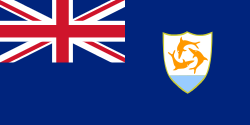Economy of Anguilla
 | |
| Currency |
East Caribbean dollar (XCD) 1 US$ = 2.7 XCD (2014) |
|---|---|
| 1 April - 31 March | |
Trade organisations | OECS, CARICOM (associate) |
| Statistics | |
| GDP | -8.5% (2009 est.) |
GDP per capita | $12,200 (2008 est.) |
GDP by sector | agriculture: (2.6%) industry: (24.4%) services: (73%) (2014 est.) |
| 3.1% (2014 est.) | |
Population below poverty line | 23% (2002 est.) |
Labour force | 6,049 (2001 est.) |
Labour force by occupation | agriculture: 4%, industry: 21%, services: 75% (2000 est.) |
| Unemployment | 8% (2002 est.) |
Main industries | tourism, boat building, offshore financial services |
| External | |
| Exports | $11.7 million (2014 est.) [1] |
Export goods | lobster, fish, livestock, salt, concrete blocks, rum |
Main export partners |
|
| Imports | $138.3 million (2014 est.) |
Import goods | fuels, foodstuffs, manufactures, chemicals, trucks, textiles |
Main import partners |
|
| Public finances | |
| $8.8 million (1998) | |
| Economic aid | $9 million (2004) |
|
All values, unless otherwise stated, are in US dollars. | |
The economy of Anguilla, which has few natural resources, depends heavily on luxury tourism, offshore banking, lobster fishing, and remittances from emigrants. Due to its small size and reliance on tourism and foreign direct investment, Anguilla is vulnerable to external economic conditions in the United States and Europe. Therefore, economic growth in Anguilla can be very volatile.
History
In the 19th century, Anguilla's major product was salt produced by evaporation on the shores of the island's lakes, which was exported to the United States.[2][3] Sugar, cotton, corn, and tobacco were also grown.[3] By the beginning of World War I, the island had been almost entirely deforested by charcoal-burners. Most of the land was held by black sustenance farmers producing sweet potatoes, peas, beans, and corn and rearing sheep and goats. Salt continued to be exported to nearby Saint Thomas, along with phosphate of lime and cattle.[4]
Modern Anguilla has focused its development on tourism, its related construction industry, and offshore finance. The first comprehensive financial services legislation was enacted in late 1994. The island was damaged by Hurricane Luis in September, 1995, and again during Hurricane Lenny in 2000.[5]
Anguilla's economy expanded rapidly from 2004 to 2007, before falling with the fastest speed in the world due to the 2008 financial crisis. Recovery began in 2010 and a 3.3% increase in GDP was projected for 2012.[6]
Industry
Major industries in Anguilla include tourism, boat building, and offshore financial services. In 1997 there was an industrial production growth rate of 3.1%.
42.6 GWh of electricity are consumed, produced entirely by fossil fuel.
Agricultural products include small quantities of tobacco, vegetables, and cattle raising.
In 2011 Anguilla became the fifth largest jurisdiction for Captive Insurance, behind Bermuda, Cayman, Vermont and Guernsey.[7] The captive industry plays an ever increasing and important part of Anguilla's financial services industry. Captive management firms, including Capstone Associated Services, have staffed offices in Anguilla in order to service the fast-growing captive insurance industry.
References
Citations
- ↑ "CIA – The World Factbook". Cia.gov. Retrieved 2015-06-30.
- ↑ Martin (1839).
- 1 2 EB (1878).
- ↑ EB (1911).
- ↑ South America, Central America and the Caribbean 2003 (11 ed.). Routledge. 2002. p. 52. ISBN 978-1-85743-138-4.
- ↑ http://www3.ambest.com/ratings/cr/reports/Anguilla.pdf
- ↑ 4. Property & Casualty 360, May 3, 2012, http://www.propertycasualty360.com/2012/05/03/831b-captives-small-option-is-increasingly-big-id
Bibliography
- Martin, Robert Montgomery (1839), "Chapter XIV.—Anguilla.", Statistics of the Colonies of the British Empire in the West Indies, South America, North America, Asia, Austral-Asia, Africa, and Europe; comprising the Area, Agriculture, Commerce, Manufactures, Shipping, Custom Duties, Population, Education, Religion, Crime, Government, Finances, Laws, Military Defence, Cultivated and Waste Lands, Emigration, Rates of Wages, Prices of Provisions, Banks, Coins, Staple Products, Stock, Moveable and Immoveable Property, Public Companies, &c. of Each Colony; with the Charters and the Engraved Seals. From the Official Records of the Colonial Office., London: William H. Allen & Co., p. 102.
- "Anguilla", Encyclopædia Britannica, 9th ed., Vol. II, New York: Charles Scribner's Sons, 1878, pp. 46–47.
- "Anguilla", Encyclopædia Britannica, 11th ed., Vol. II, Cambridge: Cambridge University Press, 1911, pp. 42–43.
![]() This article incorporates public domain material from the CIA World Factbook website https://www.cia.gov/library/publications/the-world-factbook/index.html.
This article incorporates public domain material from the CIA World Factbook website https://www.cia.gov/library/publications/the-world-factbook/index.html.